Back
Introduction: Enterocystoplasty (EC), appendico- or ileovesicostomy (APV), and antegrade continence enema (ACE) creation may create a space between the reconstruction and the anterior/posterior abdominal wall. This can result in internal herniation, closed loop obstruction, and volvulus. We aim to determine the incidence and describe the presentation, mechanism, and outcome of this complication.
Methods: This single-institution, retrospective cohort study identified patients who underwent EC, APV, and/or ACE between 1/2011 and 4/2022. Operative records for any subsequent exploratory laparotomy were reviewed. The primary outcome was internal herniation of bowel into the potential space between the reconstruction and the anterior/posterior abdominal wall.
Results: 143 patients received 241 procedures and were followed for a median of 68 (SD: 38) months. 19 patients underwent a subsequent exploratory laparotomy. The primary outcome occurred in 4 patients (including one patient who received their index procedure elsewhere) for a complication rate of 1% (3/241). Patients presented with bowel obstruction; two patients also had sudden pain following an ACE flush. These complications occurred between 19 months and 9 years (median 5 years) after the index procedure. One complication was caused by small bowel sliding under the mesentery of the EC. A second was caused by bowel herniating through/around the APV mesentery and a third by herniation through/around the ACE mesentery; these two hernias also volvulized. The etiology of one internal herniation is unknown (Table 1). 3 patients required resection of ischemic bowel and 2 required takedown of the involved urologic reconstruction. One patient died intraoperatively from cardiac arrest.
Conclusions: Internal herniation caused by small or large bowel sliding through a defect between the mesentery and abdominal wall or twisting around a channel occurred in 1% of 241 reconstructions over 11 years. The ischemia resulted in bowel resection and takedown of the urologic reconstruction or death. If possible, the surgeon should close these potential spaces. SOURCE OF
Funding: Dr. Schaeffer is supported in part by NIH K08DK119535

Moderated Poster Session
Session: MP53: Pediatrics III
MP53-07: Internal hernia with volvulus after major abdominal reconstructions in pediatric urology –a potentially devastating complication
Sunday, April 30, 2023
7:00 AM – 9:00 AM CST
Location: S504
- AS
Anthony J. Schaeffer, MD
Northwestern University Feinberg School of Medicine
Poster Presenter(s)
Introduction: Enterocystoplasty (EC), appendico- or ileovesicostomy (APV), and antegrade continence enema (ACE) creation may create a space between the reconstruction and the anterior/posterior abdominal wall. This can result in internal herniation, closed loop obstruction, and volvulus. We aim to determine the incidence and describe the presentation, mechanism, and outcome of this complication.
Methods: This single-institution, retrospective cohort study identified patients who underwent EC, APV, and/or ACE between 1/2011 and 4/2022. Operative records for any subsequent exploratory laparotomy were reviewed. The primary outcome was internal herniation of bowel into the potential space between the reconstruction and the anterior/posterior abdominal wall.
Results: 143 patients received 241 procedures and were followed for a median of 68 (SD: 38) months. 19 patients underwent a subsequent exploratory laparotomy. The primary outcome occurred in 4 patients (including one patient who received their index procedure elsewhere) for a complication rate of 1% (3/241). Patients presented with bowel obstruction; two patients also had sudden pain following an ACE flush. These complications occurred between 19 months and 9 years (median 5 years) after the index procedure. One complication was caused by small bowel sliding under the mesentery of the EC. A second was caused by bowel herniating through/around the APV mesentery and a third by herniation through/around the ACE mesentery; these two hernias also volvulized. The etiology of one internal herniation is unknown (Table 1). 3 patients required resection of ischemic bowel and 2 required takedown of the involved urologic reconstruction. One patient died intraoperatively from cardiac arrest.
Conclusions: Internal herniation caused by small or large bowel sliding through a defect between the mesentery and abdominal wall or twisting around a channel occurred in 1% of 241 reconstructions over 11 years. The ischemia resulted in bowel resection and takedown of the urologic reconstruction or death. If possible, the surgeon should close these potential spaces. SOURCE OF
Funding: Dr. Schaeffer is supported in part by NIH K08DK119535

